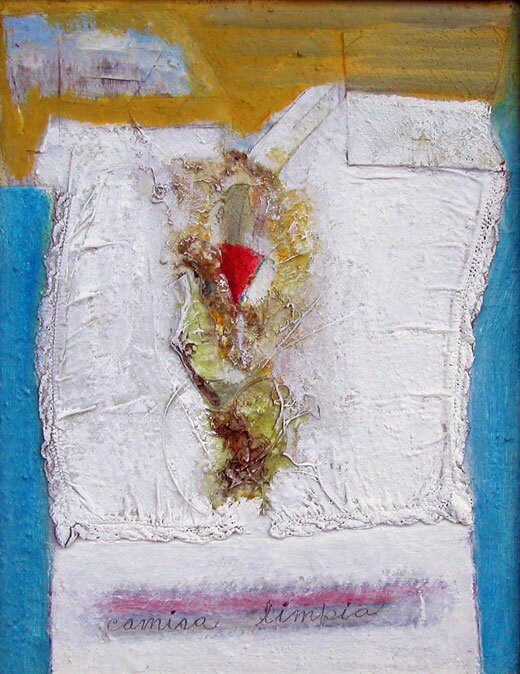T-Shirts
Posted by ben on 07 Aug 2007 at 11:40 am | Tagged as: responses/reviews
[Note: this post is part 2 in a three-part series on the work of Alberto Mijangos. Part 1, on his Chones series, can be found here.]
Alberto Mijangos was not a religious man. Although his wife is active in her Episcopal church, even singing in the choir, Alberto always maintained a skeptical distance from organized religion of all kinds. This attitude towards religion went hand in hand with his distrust of authority and his wariness of tribalism. Yet in the mid-80s Alberto started working on what he called the “T-Shirt Series”, which explores the form of the T-shirt as it relates to the Christian cross. Having associated the cross with the grand cathedrals of Mexico City, where his grandmother took him as a child, this form helped Mijangos deal with both the grandiose and the quotidian. As a form on which to base an exploration of abstraction, it is perfect: simple and direct, yet still able to express the dual nature of man. At the same time, the t-shirt relates directly to the human figure, which is where Alberto had spent most of his time as an artist. More than anything, the image of the cross was a bridge for Alberto: it allowed him to confront the spiritual and the physical; the abstract and the representational.
His use of this image may have been inspired by the work of Antoni Tapies, whose paintings, which make extensive use of the cross, Alberto greatly admired. Like Tapies, Alberto began exploring the use of inexpensive, common materials with the t-shirt series. These paintings may include house paint, sand, wax, glue, fabric, or other found materials. Just as he used the common t-shirt to approach weighty ideas about human nature, he employed common materials to give an air of earthiness to transcendent imagery.
None of this, of course, was new in the 1980s. In fact, to begin exploring abstract expressionism and arte povera in 1985 could be considered rather quaint in an art world obsessed with the new and the shocking. And yet the power of these pieces, and the later Chones series which developed out of the T-shirt Series, is undeniable on a personal level, even if they have clear historical precedents. For in the process of exploring these techniques and styles, Alberto was not just exploring formal possibilities, but he was inhabiting and reinterpreting the philosophical foundations of de Kooning, Tapies, and others. It is a testament to the power of these ideas that they can bring real meaning and awareness to the life of a man who toiled in a spiritual void as a migrant farmer, a man who was deported for being a communist, although he never really believed in communism either. Here is a man who only believed in art, in the creative process. It was, for him, the only path to redemption. To put a mark on the canvas was in fact an act of supreme faith for Alberto — the only kind of faith he could understand.
And this faith involves real peril. As Martin Buber wrote — and I think this is as good a description of Alberto’s relationship with his art as any –
“The deed involves a sacrifice and a risk. The sacrifice: infinite possibility is surrendered on the altar of the form; all that but a moment ago floated playfully through one’s perspective has to be exterminated; none of it may penetrate into the work; the exclusiveness of such a confrontation demands this. The risk: the basic word can only be spoken with one’s whole being; whoever commits himself may not hold back part of himself; and the work does not permit me, as a tree or man might, to seek relaxation in the It-world; it is imperious: if I do not serve it properly, it breaks, or it breaks me.”




